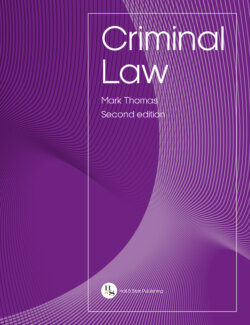Читать книгу Criminal Law - Mark Thomas - Страница 122
2.7.3.4Act of God
ОглавлениеThe defendant will not be liable if a natural event occurs which is ‘extraordinary or not reasonably foreseeable’. This is often known as ‘an act of God’. According to Henry J in the Divisional Court in Southern Water Authority v Pegrum [1989] Crim LR 442:
[A]n act of God is an operation of natural forces so unpredictable as to excuse a defendant all liability for its consequences.
Two case examples will help explain this principle.
case example
Charge: Murder
Case progression: Crown Court – Guilty
Court of Appeal – Conviction upheld
Point of law: Whether an Act of God will break the chain of causation
In R v Gowans [2003] EWCA Crim 3935, the victim was placed in a coma after being attacked by the defendant. Whilst in a coma, the victim contracted septicaemia (blood poisoning) and died. The defendant was convicted of murder and his conviction was upheld on appeal.
Kay LJ in the Court of Appeal ruled that the defendant had put the victim in a state vulnerable to any infections. The defendant, therefore, was the legal (operating and substantial) cause of the death.
Gowans is an interesting authority on the point of an ‘act of God’. The naturally occurring event was the risk of infection given that we are all at risk of infection at any point in our lives; it cannot be controlled. The defendant remained responsible for the death of the victim because the victim was placed in a situation where infection was much more likely and probable. This therefore meant that the ‘act of God’ was not unforeseeable but, rather, was a probable outcome of the defendant’s actions. As it was foreseeable, it was incapable of breaking the chain of causation.
case example
Charge: Murder
Case progression: South Australian Full Court – Guilty
Point of law: Whether an act of God will break the chain of causation where it arose as a natural consequence of the defendant’s actions
In The Queen v Hallett [1969] SASR 141 (Australia), the victim, whilst drinking on a beach at night, had allegedly made a homosexual advance to the defendant. The defendant attacked the victim and left him unconscious on the beach. The tide came in and the victim drowned. The defendant’s actions of knocking the man unconscious on the beach remained the substantial and operating cause of death.
What these two examples show is that the chain of causation is rarely broken by a naturally occurring event. As above, the natural act was not ‘so powerful’ to rid the defendant of liability.
In Gowans, the victim could not have acquired the serious infection without being first placed in a coma as a result of the defendant’s actions. The defendant was blameable, therefore, for the death. Likewise, in Hallett, the defendant left the victim on the beach when the tide was low. The foreseeability that he may be drowned by the incoming tide was high, and thus the defendant was liable. In both cases, the result was a ‘natural’ consequence of the defendant’s conduct. Thus the chain of causation was not broken.
You may ask, therefore, when an act of God will break the chain of causation. In Empress Car Co (Abertillery) Ltd v National Rivers Authority [1999] 2 AC 22, Lord Hoffmann explained that if an Act of God was ‘abnormal and extraordinary’, the chain of causation may be broken. In addition, an American academic named Perkins (‘The Law of Homicide’ (1946) 36 J Cr L & Cr) provides a rather useful example:
[I]f one man knocks down another and goes away leaving his victim not seriously hurt but unconscious, on the floor of a building in which the assault occurred, and before the victim recovers consciousness he is killed in the fall of the building which is shaken down by a sudden earthquake, this is not homicide. The law attributes such a death to the ‘Act of God’ and not to the assault, even if it may be certain that the deceased would not have been in the building at the time of the earthquake, had he not been rendered unconscious. The blow was the occasion of the man’s being there, but the blow was not the cause of the earthquake, nor was the deceased left in a position of obvious danger. On the other hand if the blow had been struck on the seashore, and the assailant had left his victim in imminent peril of an incoming tide which drowned him before consciousness returned, it would be homicide.
Another example may be where the defendant attacks the victim but leaves him in a ‘safe place’. Whilst unconscious, the victim is struck by lightning. In both examples, the lightning strike and the earthquake are unforeseen and unforeseeable and will thus break the chain of causation.
in practice
Although the chain of causation is broken in relation to the ‘end result’, ie death, the defendant remains liable for the initial act and result, ie the initial injury. Therefore, when answering a problem question, you can discount a potential offence of murder against the defendant but you may still consider his liability for a non-fatal offence.
